County of Isenburg
The County of Isenburg was a region of Germany located in southern present-day Hesse, located in territories north and south of Frankfurt. The states of Isenburg emerged from the Niederlahngau (located in the Rhineland-Palatinate), which partitioned in 1137 into Isenburg-Isenburg and Isenburg-Limburg-Covern. These countships were partitioned between themselves many times over the next 700 years.
House of Isenburg

The House of Isenburg was an old aristocratic family of medieval Germany, named after the castle of Isenburg in Rhineland-Palatinate. Occasionally referred to as the House of Rommersdorf before the 12th century, the house originated in the Hessian comitatus of the Niederlahngau in the 10th century. It partitioned into the lines of Isenburg-Isenburg and Isenburg-Limburg-Covern in 1137, before partitioning again into smaller units, but by 1500 only the lines of Isenburg-Büdingen (in Upper Isenburg) and Lower Isenburg remained. In 1664 the Lower Isenburg branch died out. The Büdingen line continued to partition, and by the beginning of the 19th century the lines of Isenburg-Büdingen, Isenburg-Birstein, Isenburg-Meerholz and Isenburg-Wächtersbach existed. Today still exist the (Roman Catholic) princes of Isenburg (at Birstein), the (Lutheran) princes of Ysenburg (at Büdingen and Ronneburg) and the (Lutheran) counts of Ysenburg-Philippseich.
"Family tree" of the Isenburg countships


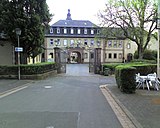


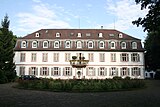
Isenburg, the original countship was divided upon the death of Count Rembold II in 1137 into:
- Isenburg (or Isenburg-Isenburg), 1137–1199, eventually dividing c. 1210 into:
- Isenburg-Braunsberg, 1210–1388, when it was renamed Isenburg-Wied. Isenburg-Wied, in turn, existed from 1388–1454, when it passed by marriage to the Lords of Runkel and was superseded by the Countship of Wied in 1462.
- Nieder-Isenburg (Lower Isenburg), 1218–1502 when it was divided into:
- Isenburg-Grenzau, 1502–1664. After the death of Count Ernest in 1664 without direct heirs, his territories were claimed back as feudal tenures by the Archbishoprics of Cologne and Trier, and the Abbey-principality of Fulda. The core territories including Isenburg were passed on by Fulda to the Counts of Walderdorff. They had to share them according to a later agreement with the Counts of Wied, by then a cadet branch of the Isenburgs.
- Isenburg-Neumagen, 1502–1554, when it passed by marriage to the Counts of Sayn-Homburg.
- Isenburg-Kempenich, 1137–1424, when it passed to the Lords of Schöneck. In 1434, it passed to the Archbishop of Trier, who sold the territory to the Counts of Virneburg.
- Isenburg-Limburg-Covern, 1137–1158, when it was divided into:
- Isenburg-Covern, 1158–1306, when it passed to Isenburg-Cleberg.
- Isenburg-Grenzau, 1158–1258, when it was divided into:
- Isenburg-Limburg, 1258–1406, when it was annexed by the Archbishopric of Trier
- Isenburg-Grenzau, 1258–1287, when it was divided into:
- Isenburg-Grenzau, 1287–1290, when it passed to Isenburg-Cleberg.
- Isenburg-Arnfels, 1286–1379, when it passed to Isenburg-Wied.
- Isenburg-Cleberg, 1287–1340, when it was divided into:
- Isenburg-Grenzau, 1340–1439, when it passed to Nassau-Beilstein. It subsequently passed to the Archbishopric of Trier in 1446, and was finally purchased by the Counts of Nieder-Isenburg in 1460.
- Isenburg-Büdingen, 1340–1511, when it was divided into:
- Isenberg-Büdingen-Ronneburg, or Isenburg-Ronneburg, 1511–1601, when it was annexed by Isenburg-Büdingen-Birstein
- Isenburg-Büdingen-Birstein (or Isenburg-Birstein), 1511–1628, which was divided into:
- Isenburg-Birstein, 1628–1664, when it passed to Isenburg-Offenbach
- Isenburg-Büdingen, 1628–1685, when it was divided into:
- Isenburg-Büdingen, 1685–1806, when it was mediatized to the Principality of Isenburg
- Isenburg-Wächtersbach, 1685–1806, when it was mediatized to the Principality of Isenburg
- Isenburg-Meerholz, 1685–1806, when it was mediatized to the Principality of Isenburg
- Isenburg-Marienborn, 1685–1725
- Isenburg-Offenbach, 1628–1711, when it was divided into:
- Isenburg-Birstein, 1711–1744, when it became the Principality of Isenburg-Birstein. The Principality existed from 1744-1806, when it was renamed the Principality of Isenburg, 1806–1814/5
- Isenburg-Eisenberg, 1711–1758, when it was absorbed back into the Principality of Isenburg-Birstein
- Isenburg-Philippseich, 1711–1806, when it was mediatized to the Principality of Isenburg
Principality of Isenburg
It was not until 1806 that there was a state called simply "Isenburg". When the Holy Roman Empire was defeated by Napoleon I of France in that year, the empire was abolished and the Confederation of the Rhine was established amongst the various German states. As an incentive to join the Confederation, it was stated that any state which joined could mediatise their neighbours. Prince Charles of Isenburg-Birstein joined the Confederation and was granted the mediatized Isenburgian Countships of Isenburg-Büdingen, Isenburg-Meerholz, Isenburg-Philippseich, and Isenburg-Wächtersbach. His Principality was renamed to Isenburg.
The Principality continued under the rule of Prince Charles through the Napoleonic era, but was mediatised by Austria in December 1813, at the insistence of King Frederick William III of Prussia, who was angered that Isenburg had raised a regiment for French service by recruiting Prussian deserters and vagabonds.[1] Isenburg was one of only three original member princes of the Empire to be mediatized at the end of the Napoleonic era (the others being Leyen and prince-primate Dalberg, Prince of Aschaffenburg). This decision was confirmed at the Congress of Vienna. The lands of the principality were divided between the Grand Duchy of Hesse-Darmstadt and the Electorate of Hesse-Kassel (or Hesse-Cassel).
Rulers
House of Isenburg
Partitions of Isenburg under House of Isenburg rule
| County of Isenburg (1041-1137) | |||||||||||||
| County of Isenburg-Isenburg (1137-1199) |
County of Isenburg-Kempenich (1st creation) (1137-1153) |
County of Isenburg-Covern (1137-1270) | |||||||||||
| County of Isenburg-Cleeberg (1167-1340) | |||||||||||||
| County of Isenburg-Braunsberg (1199-1388) Renamed as: County of Isenburg-Wied (1388-1462) |
County of Isenburg-Kempenich (2nd creation) (1199-1424) |
||||||||||||
| County of Lower Isenburg (1218-1502) |
|||||||||||||
| County of Isenburg-Limburg (1227-1406) | |||||||||||||
| Inherited by the House of Vianden (1270-1306) |
|||||||||||||
| County of Isenburg- Grenzau (1st creation) (1278-1292) |
County of Isenburg-Arnfels (1278-1371) | ||||||||||||
| County of Isenburg- Grenzau (2nd creation) (1340-1439) |
County of Isenburg-Büdingen (1st creation) (1340-1511) | ||||||||||||
| Part of the County of Isenburg-Braunsberg (1371-1388) Renamed as: County of Isenburg-Wied (1388-1462) | |||||||||||||
| To Archbishopric of Trier | |||||||||||||
| To Lords of Schöneck (1424-1434), Archbishopric of Trier (1434) and Counts of Virneburg (from 1434) | |||||||||||||
| To Nassau-Beilstein (1439-1446) and Archbishopric of Trier (1446-1460) | |||||||||||||
| To County of Wied | To County of Wied | ||||||||||||
| County of Isenburg-Neumagen (1502-1554) |
County of Isenburg- Grenzau (3rd creation) (1502-1664) | ||||||||||||
| County of Isenburg-Ronneburg (1511-1601) |
County of Isenburg-Birstein (1st creation) (1511-1664) | ||||||||||||
| To County of Sayn-Homburg | |||||||||||||
| County of Isenburg-Büdingen (2nd creation) (1628-1806) (mediatized to Isenburg-Birstein in 1806) |
|||||||||||||
| To Archbishopric of Trier, Archbishopric of Cologne and Abbots of Fulda | County of Isenburg-Offenbach (1628-1718) | ||||||||||||
| County of Isenburg-Marienborn (1673-1725) |
County of Isenburg-Meerholz (1673-1806) (mediatized to Isenburg-Birstein in 1806) |
||||||||||||
| County of Isenburg-Wachtersbach (1673-1806) (mediatized to Isenburg-Birstein in 1806) |
County of Isenburg-Philippseich (1711-1806) (mediatized to Isenburg-Birstein in 1806) | ||||||||||||
| County of Isenburg-Birstein (2nd creation) (1685-1744) Raised to Principality of Isenburg-Birstein (1744-1806) | |||||||||||||
| Principality of Isenburg (Isenburg-Birstein line) (1806-1815) (mediatized to Hesse in 1815) | |||||||||||||
Table of rulers
| Ruler | Born | Reign | Death | Ruling part | Consort | Notes | |
|---|---|---|---|---|---|---|---|
| Gerlach I | c.1060 | 1090-1115 | c.1115[2] | County of Isenburg | Unknown at least two children |
Brothers and founders of the family and the county. | |
| Rembold I | c.1060 | c.1115[2] | County of Isenburg | Unmarried | |||
| Rembold II | c.1090 | 1115-1137 | 1137 | County of Isenburg | Katharina of Arnstein five children |
Sons of Gerlach I. Brothers and co-rulers. | |
| Gerlach II | c.1090 | 1115-1120 | c.1120[2] | County of Isenburg | Unmarried | ||
| Gerlach III | ? | 1137-1158 | 1158 | Isenburg-Covern | Jutta of Are three children |
Sons of Rembold II. In 1137, they divided the land between the three. Siegfried didn't have documented children, so his land may have returned to Isenburg. After the childless death of Rembold III, his nephew Rembold IV kept Isenburg-Isenburg. | |
| Rembold III | ? | 1137-1162 | 1162 | County of Isenburg Isenburg-Isenburg |
Unmarried | ||
| Siegfried | ? | 1137-1153 | 1153 | Isenburg-Kempenich | Justina of Kempenich no children | ||
| Rembold IV | ? | 1153-1175 | 1175[2] | Isenburg-Kempenich | Unknown two children |
Son of Gerlach III. As a second son, he received the property of his childless uncles. | |
| 1162-1175 | Isenburg-Isenburg | ||||||
| Gerlach I | 1130 | 1158-1167 | 1167 | Isenburg-Covern | Unknown of Koffern three children Unknown of Leiningen two children |
||
| Gerlach II | 1149 | 1167-1217 | 1217 | Isenburg-Covern | Unknown of Covern three children |
Sons of Gerlach I, divided the land between them. | |
| Henry I | c.1150 | 1167-1227 | 1227 | Isenburg-Cleeberg | Irmgard of Büdingen (d.c.1220) eight children | ||
| Rembold V | ? | 1175-1199 | 1220[2] | Isenburg-Isenburg | Hedwig of Kampenich two children |
Sons of Rembold IV, inherited Isenburg-Isenburg, and divided it between them. | |
| 1199-1220 | Isenburg-Kempenich | ||||||
| Bruno I | ? | 1175-1199 | 1210[2] | Isenburg-Isenburg | Theodora of Wied (d.1218) four children | ||
| 1199-1210 | Isenburg-Braunsberg | ||||||
| Bruno II | 1176 | 1210-1255 | 1255[2] | Isenburg-Braunsberg | Johanna two children |
||
| Gerlach III | ? | 1217-1235 | 15 April 1235 | Isenburg-Covern | Jutta (d. July 1253) two children |
Sons of Gerlach IV, ruled jointly. | |
| Henry I | ? | 15 April 1235 | Isenburg-Covern | Unmarried | |||
| Salentin I | ? | 1218-1219 | 1219[2] | Lower Isenburg | Unknown at least one child |
Portion probably granted by Rombald V to his eldest son, Salentin. He died in Crusade next year. | |
| Theodoric I | ? | 1219-1251 | 1251[2] | Lower Isenburg | Uta of Blankenheim (d.1252) one child Adelaide (d.1258)two children |
Sons of Rombald V, ruled jointly. It's possible that Theodoric ruled in Lower Isenburg during a possible minority of Salentin's heir. | |
| 1220-1251 | Isenburg-Kempenich | ||||||
| Rosemann | ? | 1220-1264 | 1264 | Isenburg-Kempenich | Kunigunda of Büdingen-Gelnhausen (d.c.1250) one child | ||
| Henry II | c.1200 | 1227-1278 | 29 September 1278 | Isenburg-Cleeberg | Matilda of Hochstaden (d.1264) 1246 eight children |
Sons of Henry I, divided the land between them. | |
| Gerlach I | c.1200 | 1227-1289 | January 1289 | Isenburg-Limburg | Imagina of Bliescastel (1233-1281) five children | ||
| Henry II | ? | 1235-1270 | c.1270[2] | Isenburg-Covern | Matilda c.1235 no children |
After his childless death, the county is inherited by his brother-in law, Frederick of Vianden,[2] and the county stayed in his family until 1306, when it returned to the Cleberg line of the Isenburgs. From the House of Vianden, the counts in Covern were:
| |
| Covern absorbed within the House of Vianden patrimony (1270-1306), and then reabsorbed in Cleberg | |||||||
| Theodoric II the Younger | ? | 1251-1273 | 1273[2] | Lower Isenburg | Uta of Merenberg (d.1263) four children |
Son of Salentin I. Like his uncle, he may have been also involved in the government of both Lower Isenburg and Isenburg-Kempenich. | |
| 1264-1273 | Isenburg-Kempenich | ||||||
| Bruno III | ? | 1255-1278 | 29 September 1278[2] | Isenburg-Braunsberg | Sophia of Runkel (d. 26 March 1266) one child Isolda of Heinsberg (d.c.1290) c.1270 two children |
||
| Gerard I | ? | 1264/73-1287 | 1287 | Isenburg-Kempenich | Beatrice (d.c.1275) four children |
||
| Salentin II | ? | 1275-1297 | 1297 | Lower Isenburg | Agnes of Runkel (d.1316) ten children |
||
| Regency of Isolda of Loon-Heinsberg (c.1278-1284) | |||||||
| John I | c.1270 | 1278-1327 | 1327 | Isenburg-Braunsberg | Agnes of Lower Isenburg (d.1316) 1294 seven children | ||
| Louis |  |
c.1250 | 1278-1304 | 1304 | Isenburg-Cleeberg | Heilwig of Tübingen (d.c.1295) seven children |
Sons of Henry II, divided the land between them. Eberhard left no heirs and his portion was inherited by his brother Louis. |
| Gerlach I | c.1250 | 1278-1305 | c.1305 | Isenburg-Arnfels | Elisabeth of Clèves (1236-1290) five children | ||
| Eberhard | c.1250 | 1278-1292 | 25 November 1292 | Isenburg-Grenzau | Irmgard of Büdingen (d.c.1220) eight children | ||
| Isenburg-Grenzau annexed to Isenberg-Cleberg | |||||||
| Theodoric III | ? | 1287-1325 | 1323/25 | Isenburg-Kempenich | Kunigunde of Solms (d.1344) two children |
Sons of Gerard I, ruled jointly. | |
| Simon I | ? | 1287-1320 | c.1320 | Isenburg-Kempenich | Agnes of Trier 1293 two children | ||
| John I the Blind |  |
1266 | 1289-1312 | 19 September 1312 | Isenburg-Limburg | Elisabeth of Geroldseck-Veldenz (1266-1285) two children Uda of Ravensberg (1268-28 June 1313) 25 August 1292 five children |
|
| Salentin III | ? | 1297-1351 | 1351 | Lower Isenburg | Katharina one child Matilda of Covern (d.1350) six children |
||
| Lothar | ? | 1304-1341 | 4 February 1341 | Isenburg-Cleeberg | Isengard of Falkenstein (d.c.1330) five children |
||
| Theodoric | ? | 1305-1334 | 1334 | Isenburg-Arnfels | Hedwig of Neuenahr (d.c.1330) five children |
Sons of Gerlach I, ruled jointly. | |
| John | ? | 1305-1348 | 17 November 1348 | Isenburg-Arnfels | Katharina no children Jutta of Arscheid (d.c.1385) no children | ||
| Gerlach II the Elder | c.1295 | 1312-1355 | 14 April 1355 | Isenburg-Limburg | Agnes of Nassau-Siegen (d.1318) 1312 three children Kunigunde of Wertheim (d.1362) 20 December 1323 eight children |
||
| Simon II | ? | 1325-1339 | 1337/39 | Isenburg-Kempenich | Katharina of Sayn (d.c.1345) one child |
Simon II and Theodoric IV, as sons of Theodoric III, ruled jointly with their cousin, Gerard II, son of Gerard I. | |
| Theodoric IV the Arsonist | ? | 1329-1341 | 1341 | Isenburg-Kempenich | Unmarried | ||
| Gerard II | ? | 1329-1335 | c.1335 | Isenburg-Kempenich | Unmarried | ||
| William I | c.1310 | 1327-1383 | 17 July 1383[2] | Isenburg-Braunsberg | Agnes of Virneburg (d.1352/3) 1329 (anulled 12 September 1351) five children Johanna of Jülich (d.1362) 27 July 1354 one child Lisa of Isenberg-Arenfels (d. 30 November 1403) 11 November 1362 two children |
Grandson of John I. | |
| Simon III | ? | 1341-1360 | c.1360 | Isenburg-Kempenich | Hedwig of Schönberg (d.1367) six children |
||
| Henry I[3] | 1320 | 1341-1379 | 1379 | Isenburg-Büdingen | Adelaide of Hanau (d.29 July 1378) 29 July 1332 six children |
Sons of Lothar, divided the land between them. | |
| Philip I | c.1320 | 1341-1370 | 22 March 1370 | Isenburg-Grenzau | Margaret of Katzenelnbogen (d.9 July 1370) 1338 two children | ||
| Gerlach II | ? | 1348-1371 | 14 August 1371 | Isenburg-Arnfels | Elisabeth of Braunshorn (d.15 November 1339) six children Demut of Roesberg (d.c.1365) two children |
Son of Theodoric, had no surviving descendants. Arenfels went to Isenburg-Wied. | |
| Isenburg-Arnfels annexed to Isenburg-Braunsberg/Wied | |||||||
| Salentin IV | c.1320 | 1351-1364 | 1364 | Lower Isenburg | Katharina of Solms (d.2 May 1399) 25 February 1341 two children |
||
| Gerlach III the Younger | c.1325 | 1355-1366 | April 1366 | Isenburg-Limburg | Elizabeth of Falkenstein (d. 9 April 1366) 9 November 1356 no children |
Died of Black Death, without male heirs. | |
| Salentin V | c.1345 | 1364-1420 | 30 November 1420 | Lower Isenburg | Adelaide of Isenburg-Arenfels (d.1401) 6 May 1371 ten children |
||
| John II | c.1325 | 1366-1406 | 26 January 1406 | Isenburg-Limburg | Hildegard of Saarwerden (d.1419) two children |
Brother of Gerlach VI. Originally went into clergy. However, after his brother's death with no heirs, and with the permission of Pope Urban V, John put aside the office of Canon of Trier Cathedral and took over the rule of Limburg. He left no male heirs. The land went to the Archbishopric of Trier. | |
| Isenburg-Limburg was annexed to the Archbishopric of Trier | |||||||
| Simon IV | ? | 1367-1414 | 1414 | Isenburg-Kempenich | Unmarried | Sons of Simon III, ruled jointly. The death of the last one of them with no male descendants led to the annexation of the land to the Lords of Schöneck. | |
| Theodoric V | ? | 1367-1378 | 1378 | Isenburg-Kempenich | Unmarried | ||
| John | ? | 1367-1424 | 1424 | Isenburg-Kempenich | Gertrude of Hückelhoven (d.1421) one child | ||
| Henry | ? | 1367-1388 | 1388 | Isenburg-Kempenich | Elisabeth of Schönkeen no children | ||
| Kempenich annexed to the Lordship of Schöneck (1424-1434), the Archbishopric of Trier (1434) and then to the County of Virneburg | |||||||
| Eberhard | 1356 | 1370-1399 | 1399 | Isenburg-Grenzau | Matilda of the Mark (d.6 August 1406) 1371 five children |
||
| John I | 1325 | 1379-1395 | 1395 | Isenburg-Büdingen | Sophia of Wertheim (d.1389) 28 July 1355 two children |
||
| William II | 1352 | 1383-1409 | 1409[2] | Isenburg-Braunsberg | Unmarried | ||
| John II | 1360 | 1395-1408 | 1408 | Isenburg-Büdingen | Margaret of Katzenelnbogen (1365-1438) 1385 two children |
||
| Philip II | 1376 | 1399-1440 | 1440 | Isenburg-Grenzau | Margaret of Lower Isenburg (d.15 June 1441) 17 January 1395 no children |
His childless death determined that the county went to the Counts of Nassau-Beilstein, then to the Archbishopric of Trier, and finally sold to the Counts of Lower Isenburg. | |
| Annexed to the County of Nassau-Beilstein (1439), to the Archbishopric of Trier (1446) and the County of Lower Isenburg (1460) | |||||||
| Diether | 1390 | 1408-1461 | 20 November 1461 | Isenburg-Büdingen | Elisabeth of Solms-Braunfels (c.1410-17 July 1451) 26 July 1409 eight children |
||
| Gerlach | c.1365 | 1409-1413 | 1413 | Isenburg-Braunsberg | Agnes of Isenburg-Büdingen (d.4/9 July 1402) 27 September 1376[2] four children |
Half-brother of William II. | |
| William III | c.1380 | 1413-1462 | 22 October 1462[2] | Isenburg-Braunsberg | Margaret of Moers no children~ Philippa of Loon-Heinsberg (d.14 January 1464) 10 April 1402 no children |
Sons of Gerlach, ruled jointly. After William's death, Dietrich IV, Lord of Runkel, could claim the county through the marriage with Anastasia, John II's daughter. | |
| John II | c.1380 | 1413-1454 | 1454 | Isenburg-Braunsberg | Agnes of Westerburg (d.1415) 1400 two children Kunigunde of Westerburg (d. 2 February 1428) 1415 no children Kunigunde of Saffenberg (d.1454) 1428 no children | ||
| Wied annexed to Runkel's domains, and then returned to the County of Wied | |||||||
| Salentin VI | c.1375 | 1420-1458 | 1458 | Lower Isenburg | Adelaide of Isenberg-Grenzau no children Maria of Isenberg-Grenzau ten children |
Called sometimes of Grenzau, probably from his marriage. | |
| Gerlach II | ? | 1458-1488 | 6 May 1488 | Lower Isenburg | Jutta of Eppenstein (d.1421) four children |
||
| Louis II | 1422 | 1461-1511 | 4 June 1511 | Isenburg-Büdingen | Maria of Nassau-Wiesbaden-Idstein (1438-10 January 1480) 1 December 1452 ten children |
||
| Gerlach III | ? | 1488-1502 | 18 July 1502 | Lower Isenburg | Hildegard von Zirk (1430-1478) seven children |
Sons of Gerlach II, ruled jointly. | |
| James | 1456 | 1488-1502 | 17 January 1505 | Lower Isenburg | Unmarried | ||
| Salentin VII | 1470 | 1502-1534 | 24 September 1534 | Isenburg-Neumagen | Elisabeth of Hunolstein-Neumagen (1475-4 June 1538) nine children |
Sons of Gerlach II, ruled jointly. After Gerlach's death, his sons divided the county. | |
| Gerlach IV | 1490 | 1502-1530 | 9 September 1530 | Isenburg-Grenzau | Anastasia of Moers (d.24 October 1557) 5 July 1494 eleven children | ||
| Philip I | 20 March 1467 | 1511-1526 | 22 February 1526 | Isenburg-Ronneburg | Amalia of Rieneck (29 November 1478-1543) 17 June 1516 Arnstadt six children |
Sons of Louis II, divided the county between them. | |
| John III | 1476 | 1511-1533 | 18 May 1533 | Isenburg-Birstein | Anna of Schwarzburg-Blankenburg (23 February 1497-1546) 17 June 1516 Arnstadt seven children | ||
| Anton I |  |
2 August 1501 | 1526-1560 | 25 October 1560 | Isenburg-Ronneburg | Elisabeth of Wied (1508-24 July 1542) 17 June 1516 sixteen children Katharina Gumpel (1530-18 September 1559) 16 February 1554 four children |
|
| Henry the Elder | 5 January 1521 | 1530-1553 | 1553 | Isenburg-Grenzau | Margaret of Wertheim (d.25 March 1538) 2 September 1533 five children |
||
| Reinhard | 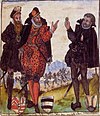 |
1518 | 1533-1568 | 28 February 1568 | Isenburg-Birstein | Elisabeth of Waldeck-Wildungen (10 December 1525-30 March 1543) 1542 one child Margaret of Mansfeld (1520-1573) 4 May 1551 Rudolstadt no children |
Sons of John III, ruled jointly. |
| Philip II | 23 May 1526 | 1533-1596 | 5 April 1596 | Isenburg-Birstein | Irmengard of Solma-Braunfels (1536-1 October 1577) 31 October 1559 Birstein ten children | ||
| Louis III | 30 May 1529 | 1533-1588 | 7 February 1588 | Isenburg-Birstein | Anna Sybilla of Schwarzburg (25 October 1540-3 August 1578) 24 June 1571 Arnstadt four children Maria of Hohnstein (1558-2 February 1586) 13 August 1581 Offenbach two children | ||
| Henry | c.1500 | 1534-1554 | 13 February 1554 | Isenburg-Neumagen | Antonia Penelope van Brederode (d.30 June 1591) 4 September 1547 ten children |
Sons of Salentin VII, ruled jointly. After their childless deaths, the county is inherited by his brother-in law, the count of Sayn. | |
| Salentin VIII | c.1500 | 1534-1554 | 1544 | Isenburg-Neumagen | Unmarried | ||
| Neumagen annexed to the County of Sayn | |||||||
| John Henry | 1534 | 1553-1565 | 15 November 1565 | Isenburg-Grenzau | Erica of Manderscheid-Schleiden (d.23 December 1587) 22 August 1563 Grenzau no children |
||
| George | 10 September 1528 | 1560-1577 | 29 June 1577 | Isenburg-Ronneburg (from 1566 in Ronneburg) |
Barbara of Wertheim (1531-17 September 1600) 21 May 1552 no children |
Sons of Anton, ruled jointly. After Henry's death in 1601, Ronneburg was annexed back to Birstein. | |
| Wolfgang | 12 June 1533 | 1560-1597 | 20 December 1597 | Isenburg-Ronneburg (from 1566 in Kelsterbach) |
Johanna of Hanau-Lichtenstein (4 April 1543-3 December 1599) 26 October 1563 (annulled 1573) one child Ursula of Solms-Braunfels (1535-21 January 1585) 16 December 1577 no children Ursula of Gleichen-Remda (d. September 1625) 19 September 1585 no children | ||
| Henry | 13 September 1537 | 1561-1601 | 31 May 1601 | Isenburg-Ronneburg (1566-1597 in Ronneburg; in all county from 1597) |
Maria of Rappoltstein (5 July 1551-15 October 1571) 1569 no children Elisabeth of Gleichen-Tona (1554-19 July 1616) 1572 no children | ||
| Isenburg-Ronneburg was annexed to Isenburg-Birstein | |||||||
| Salentin IX |  |
1532 | 1565-1610 | 19 March 1610 | Isenburg-Grenzau | Antonia Wilhelmina of Arenberg (1 March 1557 - 26 February 1626) 10 December 1577 two children |
|
| Wolfgang Ernest I | 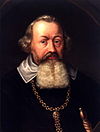 |
29 December 1560 | 1596-1633 | 21 May 1633 | Isenburg-Birstein | Anna of Gleichen-Remda (1565-3 March 1598) 26 September 1585 Birstein eight children Elisabeth of Nassau-Dillenburg (24 January 1564-5 May 1611) 16 April 1603 Frankfurt am Main one child Juliana of Sayn-Wittgenstein (26 February 1583-8 February 1627) 19 April 1616 four children |
Son of Philip II. |
| Salentin X | c.1580 | 1610-1619 | 5 December 1619 | Isenburg-Grenzau | Unmarried | Died childless. | |
| Ernest |  |
1584 | 1619-1664 | 30 May 1664 | Isenburg-Grenzau | Caroline Ernestine of Arenberg (6 September 1606 - 12 September 1630) 1 September 1625 no children Maria Anna of Hohenzollern-Hechingen (1614 - 7 March 1670) 1636 Fürstenberg one child |
Brother of Salentin X. Left no descendants. |
| Grenzau divided between the Archbishopric of Trier, Archbishopric of Cologne and Abbots of Fulda | |||||||
| William Otto | 6 November 1597 | 1633-1667 | 17 July 1667 | Isenburg-Birstein | Catharina Elisabeth of Hanau-Munzenberg (1 September 1607 - 24 September 1647) 7 November 1628 no children Anna Amalia of Nassau-Dillenburg (19 July 1599-4 May 1667) 24 October 1648 Birstein no children |
Sons of Wolfgang Ernest I, divided the land between them. William Otto didn't have descendants and his feud was briefly annexed to Offenbach, before it generates a new branch in 1685. | |
| Council of Regency, in Büdingen only (1633-1643) | |||||||
| John Ernest I |  |
21 June 1625 | 1633-1673 | 8 October 1673 | Isenburg-Büdingen | Maria Charlotte of Erbach-Erbach (24 March 1631-8 June 1693) 15 June 1650 Wechsterbach twelve children | |
| Wolfgang Henry | 21 October 1588 | 1633-1638 | 27 February 1638 | Isenburg-Offenbach | Maria Magdalene of Nassau-Wiesbaden-Idstein (11 August 1592-13 January 1654) 12 September 1609 Büdingen thirteen children | ||
| Isenburg-Birstein annexed to Isenburg-Offenbach | |||||||
| Regency of Maria Magdalene of Nassau-Wiesbaden-Idstein (1638-1640) | |||||||
| John Louis | 14 February 1622 | 1638-1685 | 23 February 1685 | Isenburg-Offenbach | Maria Juliana of Hanau-Munzenberg (15 January 1617-28 October 1643) 7 October 1643 Hanau no children Louise of Nassau-Dillenburg (22 May 1623-17 November 1685) 10 February 1646 Dillenburg eleven children Maria Juliana Blingen (d.1677) 27 January 1666 Hanau (morganatic) six children | ||
| Regency of Maria Charlotte of Erbach-Erbach (1673-1691) | Sons of John Ernest I, ruled under their mother during their minority, and then divided the land once more. | ||||||
| John Casimir |  |
10 July 1660 | 1673-1693 | 23 September 1693 | Isenburg-Büdingen | Sophie Elisabeth of Isenburg-Offenbach (10 July 1650-3 September 1692) 12 April c.1680 Offenbach am Main eight children | |
| Ferdinand Maximilian I | 3 January 1662 | 1673-1703 | 14 March 1703 | Isenburg-Wachtersbach | Albertine Maria of Sayn-Wittgenstein-Berleburg (29 January 1663-29 November 1711) 1 July 1685 Berleburg fourteen children | ||
| George Albert |  |
1 May 1664 | 1673-1724 | 11 February 1724 | Isenburg-Meerholz | Amalia Henriette of Sayn-Wittgenstein-Berleburg (9 September 1663-21 April 1707) 11 July 1691 Meerholz six children | |
| Charles Augustus | 27 January 1667 | 1673-1725 | 16 March 1725 | Isenburg-Marienborn | Anna Belgica Florentina of Solms-Laubach (9 September 1663-21 April 1707) 5 May 1690 Laubach four children | ||
| Isenburg-Marienborn was annexed to Isenburg-Wachtersbach | |||||||
| John Philip |  |
3 December 1655 | 1685-1718 | 21 September 1718 | Isenburg-Offenbach | Charlotte Amalia of Palatinate-Zweibrücken-Landsberg (24 May 1653-9 August 1707)19 July 1678 no children Frederica Wilhelmina Charlotte of Sayn-Wittgenstein-Berleburg (23 June 1684-26 June 1731) 22 July 1708 one child |
Sons of John Louis, redivided the land between them. |
| William Maurice I | 3 August 1657 | 1685-1711 | 8 March 1711 | Isenburg-Birstein | Anna Amalia of Isenburg-Büdingen (23 October 1653-12 March 1700) 3 November 1679 Birstein sixteen children Anna Ernestina Sofia von Kvernheim (1660-30 September 1708) 1700 no children Wilhelmina Elizabeth of Leiningen-Dagsburg-Falkenburg (13 April 1659-15 September 1733) 1709 Niederweisel no children | ||
| Council of Regency (1693-1701) | Died childless. | ||||||
| John Ernest II | 3 April 1683 | 1693-1708 | 31 May 1708 | Isenburg-Büdingen | Unmarried | ||
| Regency of Albertine Maria of Sayn-Wittgenstein-Berleburg (1703-1710) | |||||||
| Ferdinand Maximilian II | 12 January 1692 | 1703-1755 | 22 April 1755 | Isenburg-Wachtersbach | Albertine Ernestine of Isenburg-Büdingen (25 August 1692-11 June 1724) 28 May 1713 Büdingen nine children Ernestine Wilhelmine of Stolberg-Gedern (2 January 1695-7 May 1759) 7 December 1725 Wechtersbach eight children | ||
| Ernest Casimir I |  |
12 May 1687 | 1708-1749 | 15 October 1749 | Isenburg-Büdingen | Christine Eleonore of Stolberg-Gedern (12 September 1692-30 January 1745) 8 August 1708 Gedern eight children |
Brother of John Ernest II. |
| Wolfgang Ernest I |  |
5 April 1666 | 1711-1754 | 15 April 1754 | Isenburg-Birstein | Friederike Elisabeth of Leiningen-Dagsburg-Hartenburg (16 January 1681-11 January 1717) 27 November 1707 Weilburg seven children Elisabeth Charlotte of Isenburg-Marienborn (7 November 1695-23 September 1723) 27 January 1719 Marienborn two children Charlotte Amalia of Isenburg-Meerholz (1 September 1692-10 January 1752) 22 May 1725 six children |
Sons of William Maurice I, divided the land between them. |
| William Maurice II | 23 July 1688 | 1711-1772 | 7 March 1772 | Isenburg-Philippseich | Amalia Louisa von Donna-Lauk-Reichertswalde (27 February 1763-20 April 1800) 3 January 1712 Birstein three children Philippine Louise of Stolberg-Gedern (2 October 1705-1 November 1744) 2 April 1725 Gedern twelve children | ||
| Charles | 27 November 1700 | 1724-1774 | 14 March 1774 | Isenburg-Meerholz | Elisabeth Friederike Juliana of Solms-Rodelheim-Assenheim (23 September 1703-1 June 1762) 11 July 1691 Meerholz twelve children |
||
| Gustav Frederick | 7 August 1715 | 1749-1768 | 12 February 17 | Isenburg-Büdingen | Dorothea Benedikta von Reventlow (13 October 1734-20 December 1766) 21 November 1749 Fünen six children Auguste Friederike of Stolberg-Wernigerode (4 September 1743-9 January 1783) 5 December 1767 Wernigerode eight children |
Left no surviving heirs. | |
| Wolfgang Ernest II |  |
17 November 1735 | 1754-1803 | 3 February 1803 | Isenburg-Birstein | Sophie Charlotte Ernestina of Anhalt-Bernburg-Schaumburg-Hoym (3 April 1743-5 December 1781) 20 September 1760 Schaumburg Castle seven children Ernestine Esperance Victoria of Reuss-Greiz (20 January 1756-2 December 1819) 20 August 1783 no children |
Grandson of Wolfgang Ernest I. His father was Wiliam Emich Christoph, son of Wolfgang Ernest I. |
| Ferdinand Casimir I | 19 January 1716 | 1755-1778 | 16 September 1778 | Isenburg-Wachtersbach | Auguste Karoline of Isenburg-Büdingen (15 July 1722-30 November 1758) 7 July 1750 Büdingen two children |
||
| Louis Casimir | 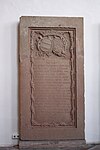 |
25 August 1710 | 1768-1775 | 15 December 1775 | Isenburg-Büdingen | Auguste Friederike of Stolberg-Wernigerode (4 September 1743-9 January 1783) 24 September 1768 Christinenhof eight children |
Brother of Gustav Frederick, married his widow, but died also childless. |
| Christian Charles | 28 June 1732 | 1772-1779 | 26 March 1779 | Isenburg-Philippseich | Constance Sophie of Sayn-Wittgenstein-Berleburg (11 April 1733-8 January 1776) 13 June 1762 Philippseich seven children |
||
| John Frederick William | 2 May 1729 | 1774-1802 | 4 May 1802 | Isenburg-Meerholz | Karoline of Salm (20 April 1734-11 May 1791) 11 June 1762 Grumbach eight children |
||
| Ernest Casimir II | 25 February 1757 | 1775-1801 | 25 February 1801 | Isenburg-Büdingen | Eleonore of Bentheim-Steinfurt (26 April 1754-18 February 1827) 25 July 1779 Burgsteinfurt eight children |
||
| Ferdinand Casimir II | 17 October 1752 | 1778-1780 | 1 December 1780 | Isenburg-Wachtersbach | Auguste Louise Clementine Hedwig of Bentheim-Steinfurt (23 September 1755-15 November 1798) 29 April 1755 Siegen no children |
Left no heirs. The county passed to his uncle. | |
| Council of Regency (1779-1781) | Left no heirs. | ||||||
| Charles William Ernest | 20 October 1767 | 1779-1781 | 30 January 1781 | Isenburg-Philippseich | Unmarried | ||
| Albert Augustus | 14 April 1717 | 1780-1782 | 25 November 1782 | Isenburg-Wachtersbach | Sophia Dorothea Wilhelmina van Rehren (15 June 1706-23 October 1758) 22 April 1756 Almelo no children Charlotte of Hesse-Philippsthal-Barchfeld (26 April 1725-9 January 1798) 9 June 1765 Meiningen no children |
Brother of Ferdinand Casimir I. Like him, he didn't have children. | |
| Council of Regency (1781-1788) | Brother of Charles William Ernest. In 1806, by German mediatisation, all Isenburg lands were absorbed into Isenburg-Birstein. | ||||||
| Henry Ferdinand | 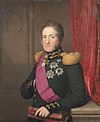 |
15 October 1770 | 1781-1806 | 27 December 1838 | Isenburg-Philippseich | Amalia Isabella Sidonia von Bentheim-Tecklenburg (6 December 1768-6 August 1822) 13 July 1789 Lemgo nine children | |
| Isenburg-Philippseich absorbed into Isenburg-Birstein | |||||||
| William Reinhard | 5 May 1719 | 1782-1785 | 5 August 1785 | Isenburg-Wachtersbach | Auguste Louise Clementine Hedwig of Bentheim-Steinfurt (23 September 1755-15 November 1798) 20 February 1784 Wachtersbach no children |
Brother of Ferdinand Casimir I and Albert Augustus. Married his sister-in-law, but didn't have heirs. | |
| Adolph I | 20 August 1722 | 1785-1798 | 19 April 1798 | Isenburg-Wachtersbach | Unmarried | Brother of Ferdinand Casimir, Albert Augustus and William Reinhard. He also didn't have heirs. | |
| Louis Maximilian I | 28 August 1741 | 1798-1805 | 23 June 1805 | Isenburg-Wachtersbach | Auguste of Sayn-Wittgenstein-Hohenstein (27 February 1763-20 April 1800) 26 April 1789 Wittgenstein four children |
Last son of Ferdinand Maximilian II. | |
| Ernest Casimir III |  |
20 January 1781 | 1801-1806 | 1 December 1852 | Isenburg-Büdingen | Ferdinande of Erbach-Schönberg (23 July 1784-24 September 1848) 10 May 1804 Zwingenberg eight children |
In 1806, by German mediatisation, all Isenburg lands were absorbed into Isenburg-Birstein. |
| Isenburg-Büdingen absorbed into Isenburg-Birstein | |||||||
| Charles William Louis | 7 May 1763 | 1802-1806 | 17 April 1832 | Isenburg-Meerholz | Karoline of Sayn-Wittgenstein-Hohenstein (13 September 1764-28 April 1833) 29 March 1785 Wittgenstein six children |
In 1806, by German mediatisation, all Isenburg lands were absorbed into Isenburg-Birstein. | |
| Isenburg-Meerholz absorbed into Isenburg-Birstein | |||||||
| Regency of Charles, Count of Isenburg-Birstein (1805-1806) | In 1806, by German mediatisation, all Isenburg lands were absorbed into Isenburg-Birstein. | ||||||
| Louis Maximilian II | 21 May 1791 | 1805-1806 | 25 February 1821 | Isenburg-Wachtersbach | Unmarried | ||
| Isenburg-Wachtersbach absorbed into Isenburg-Birstein | |||||||
| Charles | 
|
29 June 1766 | 1803-1806 | 21 March 1820 | Isenburg-Birstein | Charlotte Auguste of Erbach-Erbach 16 September 1795 Erbach six children |
In 1806, in the advent of the German mediatization, his county was chosen as the one to which all the others were absorbed to. He was then raised as Prince of Isenburg. However, in 1815, his own Principality was also absorbed, this time to the Electorate of Hesse. |
| 1806-1815 | Principality of Isenburg | ||||||
| Isenburg was annexed to the Electorate of Hesse | |||||||
Lines of succession
Mediatized line of Birstein (1815)
- Charles, 1st Prince 1803-1820 (1766-1820)
- Wolfgang Ernst, 2nd Prince 1820-1866 (1798-1866)
- Prince Victor (1802-1843)
- Karl, 3rd Prince 1866-1899 (1838-1899)
- Prince Leopold (1866-1933) -renounced his rights in 1898
- Franz Joseph, 4th Prince 1899-1939 (1869-1939)
- Franz Ferdinand, 5th Prince 1939-1956 (1901-1956)
- Franz Alexander, 6th Prince 1956–2018 (1943-2018)
- Alexander, 7th Prince 2018–present (1969) ∞ Sarah Lorenz
- Princess Alix (2015)
- Princess Zita (2017)
- Franz Salvator, Hereditary Prince (2019)
- Princess Katharina (1971) ∞ Archduke Martin of Austria
- Princess Isabelle (1973) ∞ Carl, Prince of Wied
- Princess Sophie (1978) ∞ Georg Friedrich, Prince of Prussia
- Prince Viktor (1979) ∞ Jungeun Anes Lee
- Princess Amalia (2016)
- Princess Victoria (2018)
- Alexander, 7th Prince 2018–present (1969) ∞ Sarah Lorenz
- Franz Alexander, 6th Prince 1956–2018 (1943-2018)
- Franz Ferdinand, 5th Prince 1939-1956 (1901-1956)
- Karl, 3rd Prince 1866-1899 (1838-1899)
Mediatized line of Büdingen (1806)
- Ernest Casimir III (1806-1848), in 1840 he was raised to Prince.
- Ernest Casimir IV (1848-1861)
- Bruno (1861-1906)
- Wolfgang (1906-1920)
- Alfred (1920-1922)
- Karl (1922-1941)
- Otto Friedrich (1904-1990), from the Ysenburg-Büdingen-Wächtersbach branch, adopted by Karl in 1936
- Wolfgang-Ernst, 8th Prince 1990- (b.1936) ∞ Leonille Princess of Sayn-Wittgenstein-Berleburg
- Hereditary Prince Casimir-Alexander (b.1967)
- Prince Tristan Alexander (b.2014)
- Prince Maximilian (b.1969)
- Prince Tassilo-Alexander (b.2006)
- Hereditary Prince Casimir-Alexander (b.1967)
Notable members of the family
- Imagina of Isenburg-Limburg, c. 1255 – 29 September 1313?, Queen consort of Adolf of Nassau, king of Germany
- Diether von Isenburg, c. 1412 – 1482, Elector and Archbishop of Mainz
- Anna of Isenburg-Büdingen, 1460 – 1522
- John of Isenburg-Grenzau, Archbishop-Elector of Trier from 1547 until 1556
- Salentin IX of Isenburg-Grenzau, c. 1532–1610, Archbishop-Elector of Cologne, Bishop of Paderborn
- Ernst Casimir II, 2nd Prince of Ysenburg and Büdingen, 1806-1861
- Bruno, 3rd Prince of Ysenburg and Büdingen, 1837-1906
- Princess Sophie Johanna Maria of Isenburg (born 1978), wife of Georg Friedrich, Prince of Prussia
References
External links
- Official Website – Fürstenhaus Isenburg (Princely House of Isenburg) (in German)
- Harv and Sfn no-target errors
- All articles with unsourced statements
- Articles with unsourced statements from June 2020
- Articles with German-language sources (de)
- Hesse articles missing geocoordinate data
- All articles needing coordinates
- Articles missing coordinates without coordinates on Wikidata
- AC with 0 elements
- House of Isenburg
- States of the Confederation of the Rhine
- Former states and territories of Rhineland-Palatinate
- Counties of the Holy Roman Empire
- Upper Rhenish Circle









